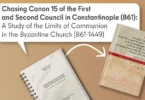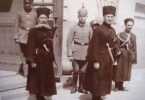From the Editor of ROCOR Studies
The present article by Bishop Nathaniel (Lvov, d. 1986) of the Russian Church Abroad is a continuation of a debate that took place after the War among eminent representatives of the Russian Church in the emigration: Bishop Nathaniel, Fr. Alexander Schmemann, Protopresbyter Mihail Polskii, Archpriest George Grabbe and Prof. Sergei V. Troitskii. In the conditions of the newly begun Cold War, three branches of the Church in the emigration – the Russian Church Abroad, the Paris Exarchate of the Ecumenical Patriarchate of Constantinople and the North American Metropolia – came to understand that it was not possible to remain subject to the Church within Russia. However, this understanding did not automatically entail their recognition of the authority of the Russian Church Abroad, which gathered together Russian political refugees scattered all across the world on the basis of ethnicity. An alternative structure was based on the territorial principle, which would have involved submitting to the jurisdiction of the Ecumenical Patriarchate of Constantinople in non-Orthodox countries. Fr. Alexander Schmemann published his articlе “A Debate about the Church” that defends subordination to the Ecumenical Throne. Here Bishop Nathanael responded to this article. Piecing together this forgotten postwar debate on our site is important in that it was a rare example of constructive, academic polemic among representatives of the Russian Church in the emigration, and also because it helps us to grasp the Orthodox teaching on the organization of church life in the so-called diaspora.
Deacon Andrei Psarev
Introduction: No Contradiction with Fr. George Grabbe
Once again, we feel obliged to respond to Father Alexander Schmemann, a priest of the Exarchate of the Ecumenical Patriarchate. In doing so, it is also once again our pleasant duty to note the dignified tone and depth of argument Fr. Schmemann displays in his article. These qualities serve to make any kind of polemicizing with him beneficial, since they enable us to shed light on a number of important and sacred questions that he addresses.
Fr. Alexander sees contradictions between Fr. George Grabbe’s assertion (quoting Prof. Sergei V. Troitskii) that “the foundation of the church’s structure is not territorial but personal (…) While episcopal jurisdiction is usually restricted to a particular territory, this is not due to any canonical principles, but rather to practical conveniences and to motives of church oikonomia”; and my statement that “while the local principle has always been and will remain normative in the external structure of the church, we do not agree with its absolutization”.
There is, however, no contradiction between Fr. George Grabbe’s and my stances on this or on any other essential church-related questions, whether in the wording of the statements quoted above or even less so in substance.
Fr. George uses the above quotation to assert that the canonical structure of the church is not based solely on the local (territorial) principle, that is to say, it is not “restricted” to it. Where it is “restricted” to it, this is primarily out of motives of oikonomia, but, on the whole, the organization of the church can be informed by both ethnic and territorial principles. This is particularly evident from the 34th Apostolic Canon: “The bishops of every nation must acknowledge who is first among them […] and each must do only those things which concern his own diocese and the places which belong to it…” Fr. George then immediately explains the reason why the territorial (local) and the ethnic principle were so closely interwoven in the structure of the church of those times – and also why the territorial principle always took precedence: “Whenever church canons discuss the boundaries of the Church, they predominantly refer to the territorial principle. Because in ancient times travel was more hazardous than now, and the children of individual Churches rarely inhabited foreign territories, the territorial and the ethnic principle normally amounted to the same thing”.
None of this means that Fr. George can be accused of ignoring the local principle in the matter of the structure of the church.
For my part, when I protest against the absolutization of the local principle, I am protesting not only against elevating it as an end in itself, but also against the exclusivity ascribed to it by Fr. Alexander. I also objected to Fr. Alexander’s assertion in his previous article that “the local principle is the root from which stem all the other diverse forms of church structure”. I pointed out, just as Fr. George Grabbe did, that the ethnic principle has no less of an important place in the structure of the church than the local one. (See the bottom of p.6 of my brochure.) Thus it transpires that Fr. George Grabbe and I were saying one and the same thing.
Therefore, Fr. Alexander’s statement that “this contradiction [between Fr. George Grabbe and myself] clearly illustrates the tenuousness and ambiguity of the canonical justifications of the Synodal jurisdiction”, is baseless.
Latin Monasteries in Byzantine Canonical Territory
I shall now go on to reply to Fr. Alexander’s historical references, with which he seeks to refute Fr. George’s arguments based on the canons.
Fr. Alexander refutes Fr. George’s assertion that there were Latin churches within the territory belonging to the Patriarchate of Constantinople and other eastern Patriarchates which “belonged to the Vine of the Universal Church as a branch of the Roman Church, although residing on the territory of Byzantium”, by claiming that “we do not have any evidence about even a single such instance” and states his bewilderment at the fact that this claim can “be made seriously in such a scrupulous article on canonical matters”.
Meanwhile, we have every reason to believe that there were indeed Latin churches and monasteries – perhaps even entire dioceses – that were situated on the canonical territory of the Patriarchate of Constantinople while nevertheless remaining under the jurisdiction of the Popes of Rome.
At the end of the 6th century, St. Gregory the Dialogist arrived in Constantinople, accompanied by a certain Maximian (subsequently Bishop of Syracuse), whom he appointed Abbot of a Constantinopolitan monastery. St. Gregory was a legate of the Roman Throne, so how could he appoint Maximian as an abbot when he was neither under the jurisdiction of Constantinople nor a member of its clergy? In 584, in a letter dated October 4, Pope Pelagius II recalled Maximian from Constantinople to Rome. Could the Pope really summon an abbot of a Constantinopolitan monastery without any prior communication with the Patriarch of Constantinople, unless this monastery was within his jurisdiction? (see “Dialogues on the Miracles of the Italian Fathers” [this title translated from Russian], III, 36 and Msgr. P. Batiffol “Saint Gregoire le Grand”, p. 37)
In 809, some Benedictine Fathers who maintained a monastery on the Mount of Olives within the territory of the Patriarchate of Jerusalem began reciting the Creed with the addition of the filioque, over the objections of Patriarch Thomas of Jerusalem. The Patriarch, who had no authority to forbid the Benedictines’ scandalous innovation, in that he had no jurisdiction over them, was compelled to appeal to the Pope of Rome. He dispatched St. Michael the Synkellos to Rome, asking the Pope to stop his monks on the Mount of Olives from leading the Palestinian faithful astray. (see The Life of St. Michael the Synkellos, December 18, and Le Qien, Oriens. christ. Vol. 3, Col. 350, and J. Pargoire, L’Eglise Byzantine, p. 294).
A Legitimate Canonical Situation
We could cite many more such historical occurrences.
Thus, in the 6th, 9th and 10-11th centuries, there were in fact Latin churches and monasteries on the territory of the Constantinople and Jerusalem Patriarchates, that nonetheless came under the jurisdiction of the Roman Church. The 1st Canon of the Council of 879, deemed Ecumenical by many church authorities, legitimizes this state of affairs. Whenever clergy residing outside their canonical territory are placed under ban by their own church authorities, the canon calls for this ban to be upheld also by the church authorities within the territory in which the disciplined cleric is serving.
In fact, it would be safe to assume a priori that any Latin church or monastery operating on the territory of the Constantinople or Jerusalem Patriarchates in the 9th century could not have been under the authority of these Patriarchates. The well-documented opposition on the part of the Greek Church authorities to such Latin practices as the addition of the filioque into the Creed, the use of unleavened bread in the liturgy, the veneration of statues, etc., signifies that neither the Patriarch of Constantinople nor the Patriarch of Jerusalem would have allowed these practices in any of churches under their authority.
In 1120, Peter the Venerable, Abbot of Cluny, wrote to both the Patriarch of Constantinople and the Byzantine Emperor asking them to return a monastery at Civetot, near Constantinople, to the authority of Cluny, since this community had always belonged to the Cluny Benedictines. (cf. B. Lieb “Rome, Kiev et Byzance”, vol. 2, ch. 5)
This historical reference is a clear indication that at some point, at a time considerably earlier than the 12th century, there was in Constantinople a monastery under the jurisdiction of the Cluny branch of the Benedictine Order (which had episcopal authority over the other monasteries in that branch through the Papal Bull of Urban II).
Representatives of the Eastern Church in the West
Such a situation, where a monastery of one jurisdiction is located within the territory of another, cannot be explained away by claiming that they belonged to different denominations. It is well-known that neither Western nor Eastern Christians considered themselves to belong to different confessions even as late as in the 12th century, yet this event took place in a much earlier period.
True, the Greek monastery of Rome did indeed belong to the Roman jurisdiction, as did all the Greek Churches in Southern Italy (Magna Graecia). However, this situation was different; these Greek churches had been Italian foundations from the beginning, as their Greek congregations were composed of Hellenes who had settled in Italy before the Birth of Christ, rather than being emigrants from some other Local Church. After all, a common language is not the only thing that determines such affiliations.
Indeed, it is widely known that persistent jurisdictional disputes arose between Rome and Constantinople in the 9th century concerning Greek parishes and monasteries in Southern Italy, disputes which could not be settled by simply referring to a “dominant” local principle.
We know that when they were in Moravia, which geographically came under the authority of the Patriarchate of the West, the brothers Sts. Cyril and Methodius changed their jurisdiction, from Constantinople to Rome. However, we also know from their Lives that this move was hardly self-evident for them – certainly not as self-evident as it would have been if they attached as much importance to the local principle of church structure as Fr. Alexander would like us to. We know that Sts. Cyril and Methodius went over to the jurisdiction of Rome not without struggle or doubts and only after much hesitation, even though this situation affected only them and the Christian peoples newly enlightened by them, which at that point had no obligations – whether moral, canonical, or conscientious – to any particular branch of the Vine of Christ.
The Case of the Church of Cyprus in Exile
On the other hand, in the case of the Church of Cyprus, we have an example of precisely such a connection, an example which sets out a canonical precedent with a deep relevance to our own situation:
“Following the Arab invasion, the Cypriot Christians, led by their Archbishop, were forced to flee the island.” The Church of Cyprus was an ancient autocephalous Church, a clearly defined branch of the Vine of Christ’s Church with her own traditions and customs and an established church life. An evil force, a newly emerged violent horde of Muslim conquerors, had captured their homeland, and, unwilling to submit themselves to the enemies of Christ, the faithful together with their pastors and archpastors chose to abandon the country of their birth. There is a profound, highly significant analogy here with both our situation in 1920 and that faced by the so-called “new émigrés” of 1943-45.
How should the Orthodox primates gathered together at an Ecumenical Council, and representing the plenitude of the Universal Church of Christ, react to such a situation? Should they declare that the Cypriot Church can only exist within the confines of the island of Cyprus, even if the Muslim power there were to crush the whole of the visible church and reduce her to a few concealed broken remnants? (At that time, no one had yet thought of a Church that justified the persecution of Christians or proclaimed Mohammed as their personal leader.) Should the Ecumenical Council ruthlessly bring the abstract local principle to its logical conclusion – namely, that the Church of Cyprus should cease to exist since Her archpastors and laity had migrated to a foreign country? Should She also be required to sever all connections with Her former church history, patterns of church life, and in particular with Her hierarchy, and submit Herself instead to the governing bishops of the Local Church into whose jurisdiction She had been forced to flee?
No, the Church did not demand any such thing. With great compassion, She allowed the Archbishop of Cyprus full jurisdiction over the territory where he and his flock settled and safeguarded his rights as a refugee bishop by the application of the 39th Canon of the Quinisext Ecumenical Council.
This episode and the canon involved in it are rendered not less, but more significant and instructive for our own time by the fact that the Patriarch of Constantinople also set the indigenous episcopal see of the locality in question – that of Cyzicus – under the authority of the Archbishop of Cyprus. This merely testifies to the breadth of the truly brotherly reaction of the Patriarch of Constantinople to the suffering of his brother-bishop at the hands of the enemies of Christ. Imagine a scenario where, in 1920, when hundreds of thousands of Russians together with their archpastors and pastors were driven out of the south of Russia, the Patriarch of Constantinople had provided Metropolitan Antony and the Synod beneath him with ecclesiastical jurisdiction over some locality or another that was a part of his own Patriarchate, while also setting the bishop of this same locality under Metropolitan Antony.
What would this have meant? It would have meant that the Patriarch of Constantinople desired the free portion of the Russian Church to be preserved, not destroyed. It would have meant that he, like his predecessor in the 7th century (evidently Paul III), wished to help his brother-bishops who were fleeing from the enemies of Christ, and to preserve the Church in question in order that it might not surrender to its enemies who were seeking to destroy it.
As far as the following phrase from the 39th Canon is concerned: “and the most God-beloved Bishop […] shall preside over all those in the eparchy of the Hellespontians” – this clearly refers to the bishops who had come with Archbishop John from Cyprus, since it goes on to read: “and [he shall] be ordained by his own bishops, in accordance with the ancient custom”. These refugee bishops are referred to as “Hellespontians” according to the new place in which they were living.
A phrase following shortly thereafter in the same canon is equally important for us: “For our God-bearing Fathers have already decided that the customs obtaining in each Church are to be continued, the Bishop of the city of the Cyzicenians (not the bishops of the Cyzicenian Metropolis) being subject to the president of the said Justinianopolis, in imitation of the rest of all the Bishops who are under the said most God-beloved president John.”[1]Fr. Alexander Schmemann’s suggestion that “all dioceses existing within this territory were subjected to the authority of the Archbishop of Cyprus”, seems incorrect to us. The diocese of … Continue reading
The Question of Metochia
We cannot agree with Fr. Alexander in refusing to admit references to the institution of metochia as guiding examples in the matter at hand. The interest of metochia for us lies in the fact that they represent the type of minimal violation of the local principle – the same principle he holds in such high regard – to which we may restrict ourselves in ordinary times.
Any Christian belongs to a particular branch of the Church of Christ, which is connected with a given nation or a given geographical area. Should this Christian then move in earnest and for a long time to a new locality within the territory of another local church, and if under some unique circumstances he is not called to defend and represent his own Church – that is, if his native Church has no need of him and releases him – then it is only natural that, as soon as he puts down sufficiently deep roots in his new life, he will receive a blessing from his former Church to enter into the ranks of the Church of his new place of residence. Yet if he has moved to this new place for but a short period of time, it is of course more beneficial to his soul and more pleasant for him not to break with the practices and norms of his native church to which he is accustomed. This is precisely the immediate spiritual need that was served by metochia of local churches within each other’s territory.
“Normal” and “Abnormal” Conditions of Church Life
Subsequently, Fr. Alexander, in attempting to rebut the notion that the exceptional character of the current position of our Church can be explained to a great degree by the abnormality of the present era, poses the question: “Then did the Church in the era of the persecutions live in normal or abnormal conditions?” For him, the obvious answer is that the conditions of life for the Church were abnormal at that time, too, and yet the local principle remained intact.
But when we speak about the abnormality of contemporary church life, alongside the abnormality and tribulation of Her external situation of persecution, we also imply that her internal state is abnormal. The latter is, to an even greater degree than the former, the cause of her hardships. And one of the most glaring manifestations of this abnormality in contemporary church life can be seen in the attitude of the other local Churches, apart from those of Serbia, and partially also of Bulgaria and Antioch, to the Russian Church, which has suffered so greatly at the hands of the enemies of Christ.
We can consider as normal such relations between sister Churches as existed between those of Cyprus and Constantinople in the 7th century, and between those of Russia and Serbia at all times.
Can we imagine that, in a time of normal relations among Churches, the primate of one Church would side with those rebelling against the primate of another in flagrant disregard of all the canons, while also demanding that the latter primate be removed from office, as was the case with respect to the Church of Russia in 1924?
In ordinary times, even that one act would have sufficed to disturb the peace among the Churches, provided that this sinful error was not effaced by an admission of wrongdoing and by repentance on the part of the guilty party. And yet, in the matter at hand, such repentance has never been forthcoming.
Can we regard as normal the “jurisdictional variations” and “twists and turns in church policy”, as Fr. Alexander Schmemann calls them, on the part of a branch of the church that has altered its position six times in 18 years? [Bp. Nathaniel here refers to the Western European Metropolitanate under Metropolitan Evlogy during the conflict with ROCOR and Moscow Patriarchate in the 1920s-1930s —ROCOR Studies] Initially, it broke away from its brethren and placed itself under the authority of a church that had settled on a compromise with a God-hating regime. Next, it abandoned this jurisdiction and came under the authority of a different Local Church – only to make a subsequent abortive attempt to return to the correct canonical path and then, without explanation, to repudiate this attempt, too. It then re-joined the same church whose administration had become amalgamated with the enemies of God and, finally, left it also to place itself under the omophorion of another hierarchy.
Support and Opposition from other Local Churches
We consider the official “friendly” and “fraternal” relations that have been demonstrated towards the Moscow Patriarchate for quite a number of years to be a sign of the deeply abnormal state of the contemporary life of the church, as the very same Moscow Patriarchate extols the enemies of God and condemns His martyrs. A normal state of affairs in the church requires that all Local Churches have compassion and zeal for their brother who is hardened in mortal sin. A truly fraternal attitude would require them to rebuke him fervently for his sin instead of remaining politely indifferent to such a grave offense. If a normal state of affairs of this kind prevailed in the church, we would not be so agonizingly isolated in our church-political stance as we are now.
We will not begin to speculate on how our relationships with the heads of the Local Churches would have unfolded if, after we had left our own country following our defeat in the struggle with the enemies of Christ, we had encountered in exile the same attitude evinced by Constantinople with respect to the Archbishop of Cyprus in the 7th century, as well as to us and our Supreme Ecclesiastical Authority – initially – in the 1920s.
In any event, our aim to preserve the free portion of the Russian Church, at any cost and despite the concerted efforts of our enemies, would have found support among our brethren.
We have found an example of such a friendly attitude in the Church of Serbia. Thus, while maintaining our firm and principled affiliation with the Church of Russia, we have been able to allow the primates and hierarchs of the Serbian Church to exert a deep and multifaceted influence on our own church life, in the knowledge that we will only benefit from this.
We must preserve the Russian Orthodox Church, the branch of the Vine of Christ to which we belong not arbitrarily, but by the will of God. Can this impulse possibly be uncanonical?
The forces of the devil are seeking to bring our Church to ruin in our homeland, both through direct persecution in the form of bloodletting and through the temptation to make compromises. Initially gross, these later became more subtle while still being connected with the church’s inner bondage and betrayal of the truth. The part of our church in our native land that has remained entirely faithful to the truth has descended into complete obscurity and cannot bear witness to its own self.
Under these circumstances, we have maintained an organic unity with both the hidden confessors of God and with all those within our church who do not wish to resign themselves to lies uttered in Her name. We are able to bear witness to both the hidden suffering of these confessors and to the concealed expectations of clergymen living in bondage. Yet it is we who are being called to leave the Russian Church and to join another branch of the Church – which is tantamount to calling for the destruction of the free portion of the Russian Church that is able to bear this witness, for the destruction of Her voice. And they try to pass off such demands as if they were speaking on behalf on the canons, that is, on behalf of the Holy Spirit!
How then can Fr. Alexander Schmenann and his adherents react with surprise when we speak thus of their struggle against us: “This is a struggle against the Russian Church Abroad, with the aim of bringing about Her destruction.” For what else can we make of their demand that all Russian dioceses, churches, and monasteries outside of Russia be subject to the Patriarchate of Constantinople or else that new Local Churches be formed? Our bitter incomprehension at this is entirely legitimate, as we think: “Surely those who have become the instruments of such a struggle know not what they do?”
The Aim of Good Relations
Fr. Alexander reproaches us by saying that, instead of seeking unity among the Churches (which he perforce associates with us departing from the Russian Church and submitting to Constantinople or creating a local church), we often state our desire merely to maintain “good relations”.
This is not accurate. We have no less of a thirst for genuine church unity than he does. Yet we see the prospect of unity not in departing from the Church in which we have been placed by God’s will, but rather in total faithfulness to Her. We have never belonged to the Church of Constantinople, and there are no grounds whatsoever for demanding that we should. One can only move from one Local Church to another with the permission of one’s own Church. The archpastors, pastors, and laypeople who have separated themselves from us (the Russian Church) received the grace of Baptism – that is, the sacrament of entrance into the Church – within the Russian Church, and, in many cases, the grace of the Priesthood as well. For this reason, we have every ground to call for their return.
The Russian Church never gave its blessing to their departure. There was not even an iota of God’s will in all these variegated twists and turns. Their departure was entirely self-willed and it inflicted a most painful wound upon not only the Russian Church, but also on the entire Universal Orthodox Church, since it immediately lowered Her prestige in the eyes of outsiders and in the consciousness of its own children, degraded the overall level of church life, and has been the source of myriad calamities.
If only they could be returned to the path that they once trod together with us!
This would be a festivity for men and angels alike. It would be a true solemnity of the Church and a foundation for true unity. How much easier it would then be, at least here in Europe, to resolve all church-related questions, in that a much healthier seed would already have been sown for the future emergence of a local Orthodox Church. It would be easier in that case because the largest branch of Orthodoxy, the Russian one, would not project a most sorrowful image of division, but would be strong and glorious by virtue of its unity, founded upon the will of God rather than upon human reasonings.
But what if this is not possible? And if indeed, when one looks at the conditions of local church life, the above-mentioned highly desirable result appears impossible, then one ought to hope at least for “good relations”, so long as the jurisdictional division continues to exist and it is not in our power to heal it. Good relations are in themselves positive insofar as they reduce the level of spiritually harmful fractiousness to a minimum amount, such that, thought it may always still be palpable, yet it is not as painful as outright divisions. Further, good relations help to mollify the scandal of our divisions for both the children of our own churches and for outsiders. Lastly, good relations make it easier to search for and find paths towards genuine unity.
And, as we have indicated on several occasions, good relations between us and representatives of the Constantinopolitan Exarchate are indeed possible. One very good way to establish good relations, for example, is joint work in the area of charitable activities. On quite a few occasions, we have made suggestions to this effect to representatives of the Exarchate of the Ecumenical Patriarchate, but these invariably met with an indelicate rejection.
A circumstance which is an additional source of scandal in this regard is the fact that the representatives of the Constantinopolitan Exarchate, while remaining implacably opposed to us, have displayed an extensive and wide-ranging tendency toward appeasement in ecumenical relations with the heterodox, whereas the reverse ought to be true, considering that the Gospel commandment states that one must have love for one’s neighbor, rather than for those who are at a far remove.
The Territorial Principle versus Genuine Unity
Let us now move on to examine the deepest aspect of the question under consideration.
Fr. Alexander profoundly and correctly goes about developing the idea of the nature of the Church in Christ, which includes the principle of unity. We are very happy to agree with these lines of Fr. Alexander’s article. But we cannot agree that the single nature of the church is realized predominately via the local principle and that the existence of two or more church organizations in one place is in violation of the unity of the Church as the Body of Christ.
We all confess unity to be a most sacred and fundamental property of the Church. “I believe in one Holy, Catholic, and Apostolic Church.” Fr. George Grabbe wrote a very profound and important work about the unity of the Church, which can serve as an important piece of evidence for not accusing him of a disregard for the principle of the unity of the Church.
It is only with these words of Fr. Alexander that we cannot agree: “There is not, and cannot be, any alternative principle of external structure of the church apart from the local principle, since it alone makes it possible to gather people together in the Church, that is, in Christ.”
We cited several examples of isolated (and never foundational) violations of the local principle from the history of the church. Never in the slightest did these irregularities affect the unity of the Church as the Body of Christ or that of Her Divine life.
The Russian metochia in Constantinople and those of the Greeks in Russia even served as valuable, edifying examples of the unity of the Church, despite the differences in language and in the names of the hierarchs who were commemorated in them.
The unity of the Chruch manifests itself predominately not in the local principle but in the unity of Her Divine life, as lived even by us sinners, insofar as we live the life of the Church. “And so there you are standing in Church, and sometimes there are days when you perceive everything the Church tells you with such clarity and profundity. Listen and be glad: these things are being said and sung by the Divine life that is opening up before you.” So taught the profound contemporary theologian Archbishop Gabriel [Chepura]. The united Divine life of the Church can be realized not only in the Divine Services. It can also exist through a unified understanding, a unified approach to church-related and other questions on the part of people living a united life within the Church.
At the present time, the greatest blow dealt to the sacred and truly fundamental principle of the unity of the Church comes not from the existence of two or three church entities in one locality, but rather from the abnormalities in the life of the Church that have been listed above. These very abnormalities gave rise to the lamentable phenomenon that in France there are several branches of the Russian Church, which view their obligations as members of the Church and the proper Christian standpoint on issues of global significance in various different ways. These variations in people’s understanding of their obligations as Christians causes palpable damage to the principle of the unity of the church, since, when Christians have different understandings of their obligations and orientations, there cannot be true unity, even if they submit to a single ecclesiastical hierarchy.
The existence of multiple church entities in one place, so long as they are divided among themselves not by variations in their understanding of the orientation of the church, but rather by different ethnicities, does not do any harm to the unity of the church, for the precise reason that the ethnic principle is natural, and like all natural things, it is neutral, neither good nor evil in its essence. Multiple churches can exist in one place and use various languages and forms, and yet still live absolutely the same life, as long as they have a unified understanding of their orientation, and educate their spiritual children to be faithful in their capacity as members of the One Church of Christ, in their own branch of the One Vine of the Lord.
Materials of the Ensuing Discussion Posted on This Website
1948. Archpriest Michael Polsky, “The Canonical Position of the Supreme Church Authority in the USSR”
1949. Priest Alexander Schmemann, “The Church and Church Structure: Regarding the book by Archpriest Polsky The Canonical Position of the Supreme Church Authority in the USSR and Outside Russia”
1949. Archpriest Michael Pomazansky, “Our Church’s Legal Consciousness”
1949. Bishop Nathaniel, “On the Destiny of the Russian Church”
1950. Priest Alexander Schmemann, “A Debate About the Church”
1952. Priest Alexander Schmemann, “Epilogue”
References
| ↵1 | Fr. Alexander Schmemann’s suggestion that “all dioceses existing within this territory were subjected to the authority of the Archbishop of Cyprus”, seems incorrect to us. The diocese of Cyzicus was twice in its history made into a Metropolis, in other words, came to have charge of several dioceses. The first occasion was in the 4th century, when Archbishop Menophantus of Ephesus fell into the heresy of Arianism and the Bishop of Cyzicus was entrusted with caring for the churches of Asia Minor. Cyzicus was again made a metropolitan city in the 10-11th centuries when the Bishop of Cyzicus was given control of initially 12 and later 14 dioceses located on the mainland of Asia Minor. In the 7th century, however, the Diocese of Cyzicus was an ordinary diocese within the Metropolis of Constantinople, which status it reassumed in the mid-8th century, when the Cypriot bishops and their flock returned to their native island after an exile of 50 years. |
|---|











